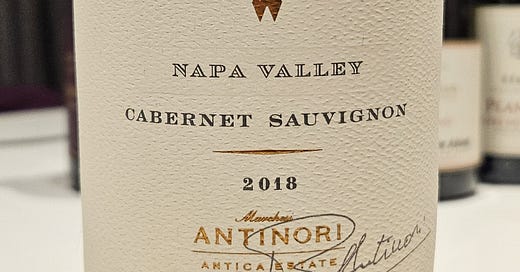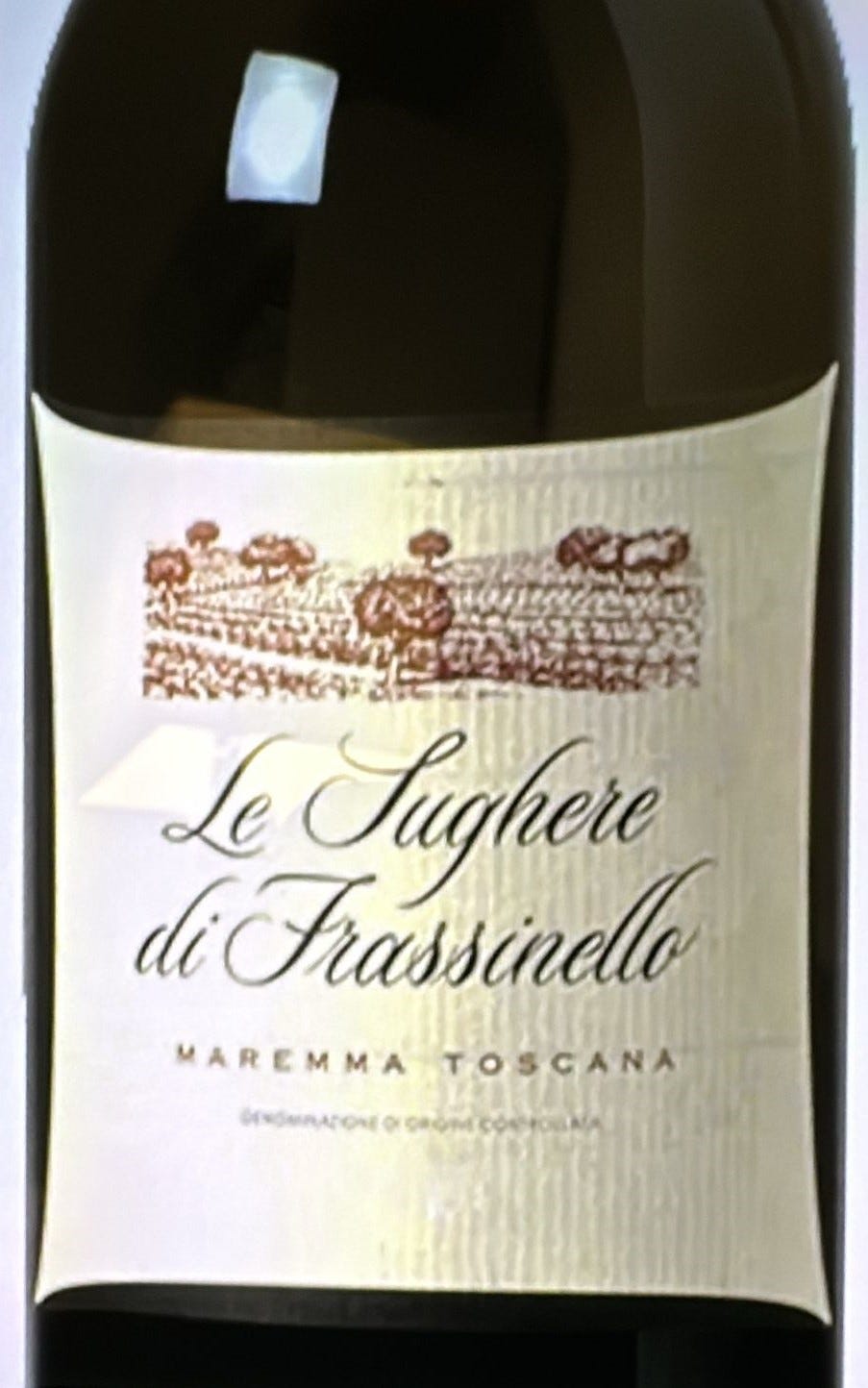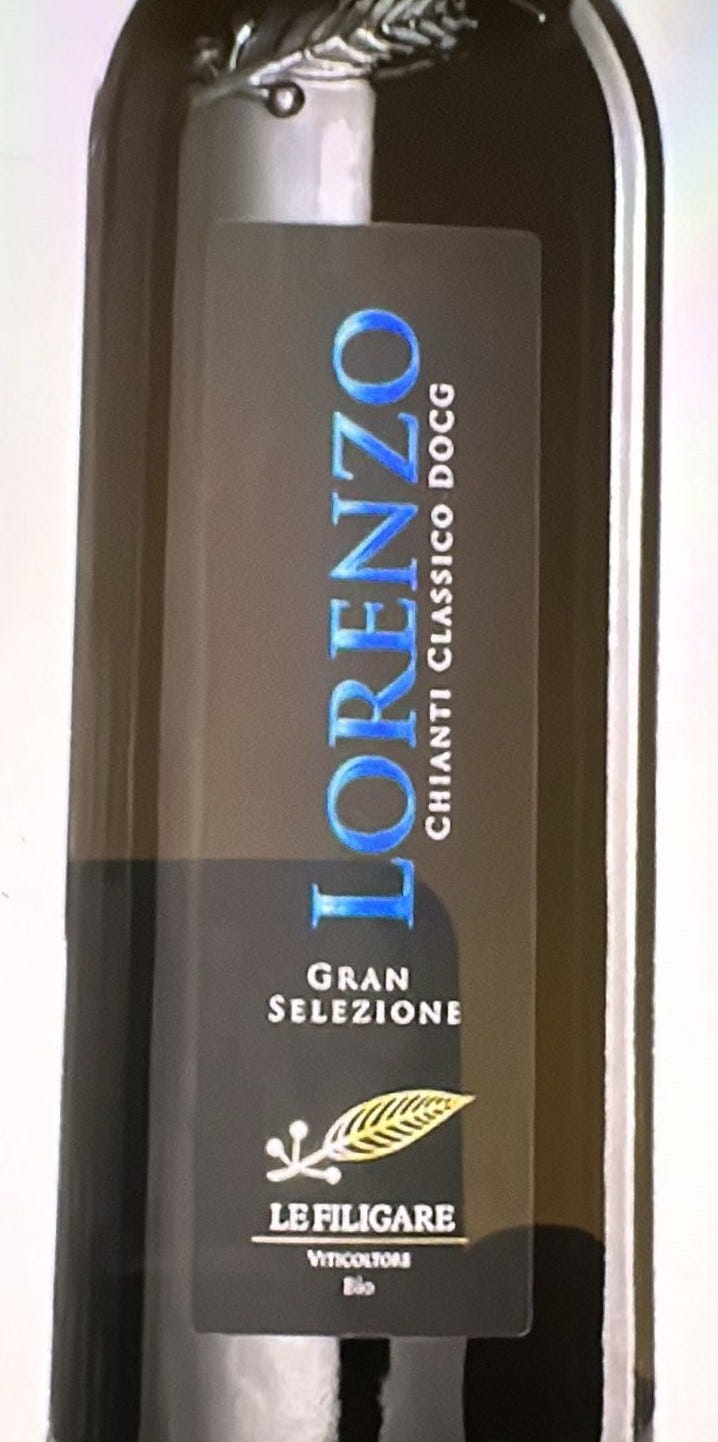I’m at that stage of my life where I’d much rather spend money on experiences than on “things.” Sharing a meal and/or a special bottle of wine with someone is far more meaningful to me than another gadget. And no, I don’t want/need an air fryer for Christmas. That said, please don’t ask how much Cousin Jano and I spent on dinner the other night because you’d be shocked (and I’m too embarrassed to tell you.) It was worth every penny, though.
So, with that in mind, here are some suggestions for where you might want to spend a little bit more money on wines for your holiday dinner table. I’m going to take an “if you normally drink this, try this instead” approach. It might be going from an inexpensive California Cab to a more expensive one, or going for a Sancerre (rather than your usual New Zealand Sauvignon Blanc) or Chablis (rather than an inexpensive Chardonnay.) OK, here we go!
Bordeaux Grapes
These are your cabernet sauvignons, merlots, cabernet francs, etc., so if you like those, here’s where to start. Bordeaux wines can be confusing and intimidating because, unlike most other regions and countries, they don’t list the grape varietal on the bottle, just the Château and the appellation (or sub-appellation) the wine comes from. And Bordeaux wines are rarely just one varietal, they are blends of many different grapes. You have to do a bit of homework to know that wines from the left bank in Bordeaux are primarily Cabernet Sauvignon-based, whereas those from the right bank are primarily Merlot. My best advice when looking to buy a Bordeaux is to ask the product consultant at your local store. Tell them whether you prefer, Cabernet Sauvignon, Merlot, or Cabernet Franc, how much you want to spend, and whether this is something you want to hold onto for a while, giving as a gift, or looking to drink this holiday season.
Bordeaux-style blends from other countries are sometimes called Meritage (merit-idge, not meri-TAHJE, as we would instinctively say in Canada,) which is a term coined in California, but used in many other regions now. One such blend from British Columbia that I love is Black Hills Estate Nota Bene 2020 ($72) which is now available here in Ontario (previously, you had to buy it directly from the winery in Oliver, BC.)
If you’re a fan of California Cabernet Sauvignon and want to splurge, there is no shortage of wines to choose from in the $100+ range. And if you want to be vintage-specific, 2018 was known to be a spectacular year.
I have a bottle of 2018 Townsend Vineyard from Antinori, a top rated producer in Napa. I think it’s the most expensive bottle of wine I’ve ever purchased and I’m not sure when I’ll be ready to open it!
With Cabernet Sauvignon being such a popular and hardy grape, you can’t go wrong with wines made in Australia (Barossa Valley,) British Columbia (Okanagan Valley,) and Chile (Maipo Valley.) I wrote a post a few months ago about some mid-priced Cabs from regions other than France or California.
Burgundy (Bourgogne) Grapes
Bourgogne, France, is the home of Chardonnay and Pinot Noir, some of the most coveted (and expensive) wines in the world, including Champagne. There was a time back in the ‘60s and ‘70s (especially in California) that all white wine was called “Chablis” or “White Chablis,” all red wine was called “Burgundy” or “Red Burgundy,” and all sparkling wine was called “Champagne.” But Burgundy, Chablis, and Champagne are all protected terms referring to specific regions in Bourgogne, so they all had to stop using those terms on their bottles.
Pinot Noir—also sometimes known as the “heartbreak grape” because it can be so difficult to grow—is the primary red grape in the region. It’s also grown in many other parts of the world including California, Oregon, Washington, Ontario, Chile, and New Zealand and will taste quite different based on where it’s produced. In Bourgogne, there are multiple sub-appellations, more than in any other region in France. You really can break the bank buying a Pinot Noir from appellations such as Côte de Nuits and Côte de Beaune. Along with Bordeaux, Bourgogne’s appellations are very specific and can appear complicated to the uninitiated. It also important to note some of the terminology you’ll see on the bottles such as “Grand Cru” (the most expensive,) Premier (1er) Cru, then Village and Regional appellations. I’d have to do a lot more homework to be able to write confidently about it, so I’m going to suggest a few Pinot Noirs that are of high quality, but won’t break the bank.
Maison Roche de Bellene Vieilles Vignes Nuits-Saint-Georges 2016 ($79)
Maison Louis Latour Marsannay 2020 ($46.75)
If you’re looking for a Pinot Noir from other regions, you can read my post from a few months ago, or you could try one of these:
Sanford Santa Rita Hills Pinot Noir 2022, California ($44.95) - this is my favourite, and it’s the one Miles drank in Sideways (2004). I don’t see it very often here in Toronto, so I’ll have to buy some before it’s all gone (though I’m going to have to drive up to the north-west end of the city to get it.)
Morgon Twelve Clones Pinot Noir ($40USD) is Hilary’s favourite Pinot, though I’m not sure where/how we can get it here in Canada.
Domaine Queylus La Grande Réserve Pinot Noir 2021 ($65.70) - I’d be remiss if I didn’t recommend an Ontario Pinot Noir since it’s made so well here.
Chardonnay is one of the most planted grapes in the world (and also one of the most divisive.) Some people like the big, buttery, vanilla oak bombs from California, whereas others do not. My recommendation for the people who say they don’t like Chardonnay, is to try Chablis or Pouilly-Fuissé. The wines I’m suggesting below are all from the same producer so that you can see the price variations from one region to the next.
Chablis wines are typically un-oaked, so they will be fresher and have livelier acidity, making them perfect with food. This one from Chartron et Trébuchet Chablis 1er Cru 2022 ($50.95). “1er Cru” (premier cru) wins from Chablis will run you $50-100/bottle, and Grand Crus are usually well over $100. There are only 7 Grand Crus in Chablis.
Pouilly-Fuissé does spend some time in oak, so it will be a bit softer and have more of those vanilla notes, but not in an overpowering way. Here’s one to try for $49.95: Chartron et Trébuchet Pouilly-Fuissé 2022
When Hilary and I took our wine courses at George Brown College in the late ‘90s, our instructor gave us a little tip, which was to look for wines from the Saint-Veran appellation as it was near to Pouilly-Fuissé, but didn’t have the same hefty price tag. They’re typically in the $30 range, but are not super well known, so you might have some trouble finding them. Here’s one you can try that would be wonderful with turkey: Chartron et Trébuchet Saint-Véran 2022 ($29.95).
We can’t leave Burgundy without talking about Champagne. It can be made with a single grape (e.g., Chardonnay, which is then often called “blanc de blancs” meaning, white from white grapes,) Pinot Noir, or a blend of Pinot, Chard, and other grapes. It’s up to the winemaker to determine the percentage of each grape in the finished product. The OG Champagne is Dom Pérignon, which fetches $300+ per bottle, so maybe save that for a very special occasion. A more reasonable option might be the classic Veuve Cliquot ($86 - though I’m told that it’s now sold at Costco in Ontario for about $4 less after taxes and bottle deposit.) Another one I quite like is Taittinger Brut Réserve Champagne ($80, currently on sale for $73.90 at the LCBO.) The one thing to look for and consider when buying Champagne is the level of sweetness. Personally, I don’t love bone-dry Champagne (i.e., Extra Brut, with less than 3g/L of residual sugar) preferring the Brut style, with 7-12g/L of residual sugar. “Extra sec” has up to 17g/L and “Sec” has up to 32g/L, which can be quite puzzling considering that “sec” means “dry.” One other thing to consider when buying Champagne is that most won’t have a vintage year on the bottle, unless the winemaker declares that year’s wine to be of vintage quality. Those years (which vary by producer) will have the year on the bottle and will typically be more expensive than their regular offering.
Rhône Wines
I wrote a lot about Rhône wines and Rhône blends last month, so if you haven’t read that, there are some good recommendations there. But for my holiday table, I’d be hard pressed to pick a more elegant wine than Châteuneuf du Pape. This was my dad’s favourite wine (and he always bought the one that was sold in the crooked, dusty bottle - you know the one) so I like to drink it in his honour. With up to 18 different grapes allowed by the appellation’s rules, each producer’s wine is going to be slightly different, but with Grenache as the primary grape it will be juicy, earthy, gamey, and savoury. It’s usually a medium-bodied wine that is very fragrant. Look to spend at least $50, but more like $70+ on a bottle. Two that I am eager to try are by Xavier Vignon Cuvée Anonyme Châteauneuf-du-Pape 2012 ($119) and Halos de Jupiter Châteauneuf-du-Pape 2021 ($62). That same producer also makes a C-de-P at $90, which also sounds wonderful.
Hermitage and Crozes-Hermitage are Syrah-based wines from the northern Rhône Valley, the former being the more expensive of the two. If you love Syrah and are really looking to splurge, you’re looking at a minimum of $100 (or several hundred dollars) for a bottle of Hermitage. Some of the popular producers in the region are Guigal, Chapoutier, and Jaboulet, so look for those. Here’s one at $148 from Paul Jaboulet called La Maison Bleu Hermitage.
At a slightly lower price point, Cousin Jano and I had a lovely Crozes-Hermitage by producer J. Denuzière at dinner the other night that retails for around $47, though it’s only available in Ontario through an importer (or maybe at a bottle shop near you) but I also found it for almost half the price at the SAQ (Quebec liquor board store) so if you live in Quebec (or close by) you’re in luck. Most Crozes-Hermitages will be in the $38-60 range.
Italian Wines
Italy deserves its own post, which I promise to do in 2025. But for now, I will just leave you with a few options. As with many other countries (e.g., France with it’s AOC system,) Italy has strict rules about which grapes can be used in each of their regions. They use DOC and DOCG as their official designations, so be sure to look for that on the bottle. DOCG is a higher level of quality, but there is one other classification, IGT, which is used for wines of high quality that use grapes other than what is typically allowed in those regions. Enter, Super Tuscans.
Super Tuscans are so named because they are made in Tuscany, but don’t use the traditional Tuscan grapes (e.g., Sangiovese.) In order to be “allowed” to make wine from grapes like Cabernet Sauvignon and Merlot, they are given the Toscana-IGT designation. One recommendation from Hilary is Le Sughere di Frassinello 2018 ($44.49).
If you want to go with a classic Italian wine, you will be well served with a Chianti Classico (also from Tuscany.) This is another one recommended by Hilary. Chianti Classico Gran Selezione DOCG Lorenzo (About $75).
Finally, you can’t go wrong with a robust Amarone or Ripasso, especially if you’re serving meat rather than turkey. Amarone is made with dried grapes, mostly Corvina, that are then pressed, yielding a highly concentrated juice with which the wine is made. Ripasso is one step down from Amarone (price wise) in that they put the leftover skins from the Amarone into the freshly pressed grapes, imparting that same raisin-ey flavour, but at a lower cost. Valpolicella uses the same blend of grapes as both Ripasso and Amarone, so if you like that blend (Corvina, Rondinella, Molinara) it’s a great choice at a very reasonable price point. Here are three from the same producer:
Zenato Amarone della Valpolicella Classico ($54.95, on sale for $49.95)
Zenato Ripassa Valpolicella Ripasso Superiore ($29.95)
Zenato Valpolicella Superiore 2021 ($17.95)
White Wines
I’m not really doing them justice by lumping these all into one category, yet here we are. While there are so many white grapes to choose from (and I talked about Chardonnay above) I’m going to focus on Sauvignon Blanc and Riesling. Just like popular reds, these whites come from many different regions and countries, and at many different price points.
If you normally drink Sauvignon Blanc from New Zealand in the $16-20 price range, I’ll suggest that you try something a bit different (and a bit more expensive) from France, either from Sancerre or Pouilly-Fumé, both in the Loire Valley. [Don’t confuse Pouilly-Fumé (Sauvignon Blanc) with Pouilly-Fuissé (Chardonnay.)] One of my go-tos is Henri Bourgeois Les Baronnes Sancerre ($36.95) that has the typical minerality and aromas of grass, gooseberry, and grapefruit. This is the perfect wine for the seafood lover in your life. The same producer also makes Pouilly-Fumé La Demoiselle de Bourgeois ($61) if you’re looking for something even more refined.
For Riesling, Germany (Mosel) and France (Alsace)—along with Canada—are the places you want to look. Most people are afraid of Riesling due to preconceived (and misinformed) ideas that Riesling is always a sweet wine. It can be, but if you look for certain things on the label, you’ll find one to suit your tastes. In Germany, look for the word “trocken” on the label, which means “dry.” Personally, I’m not afraid of a little bit of sweetness in a Riesling since its high acid content balances out any sweetness. Besides, every wine has its place on your table, and perhaps an off-dry Riesling would be great along with a cheese board and some fruit compote.
For example, this wine Hofmann Hundertgulden Riesling Trocken 2021 ($49, on sale for $39.25) only has 4g/L of residual sugar, so it’s going to be bone dry, but with lively acidity and juicy fruit flavours of peaches, pears and pineapple.
From Alsace, which is a region in north-eastern France, right on the border of Germany and Switzerland, you’ll also find dry Rieslings like this one that is is highly rated Bestheim Riesling Grand Cru Schlossberg 2021 ($36).
Ontario is also known for its Riesling, given that it has a similar climate to Germany. [Fun fact: Ontario isn’t really a “cool climate” as many people think. We do have very cold winters, but our summers can be really hot.] Cousin Jano and I loved this one from Charles Baker Picone Vineyard Riesling 2021 ($44.95). We even met the legendary Charles Baker himself at a wine tasting event back in October. At 21g/L, this one has a higher sugar content than the other two, but it’s so well balanced I wouldn’t call it sweet.
OK, I’m ready to start planning my wine selections for the holiday season. How about you? What will be on your table this season?







Future wine post idea. Buying wine direct from importers. In the days when LCBO did in store tastings and wine education was part of in-store consultants job I became friends with the consultant, who now works for a small importer that represents a few wines in the LCBO but a larger number imported for restaurants and small bottle shops. We now buy some wine directly through her. Most importers offer direct sales although the catch is frequently a 6 or 12 bottle minimum, sometimes of a single wine but most allow mixed cases. HST is usually added rather than included in the listed price. The advantage is the choice as they supply restaurants and small retailers they can import wines from smaller producers in volumes too small for the LCBO to be interested in. You don't have to visit many winerys to realize some of the best wine comes from the smallest producers.
Hi Leslie glad to be add to the list enjoying each new post.